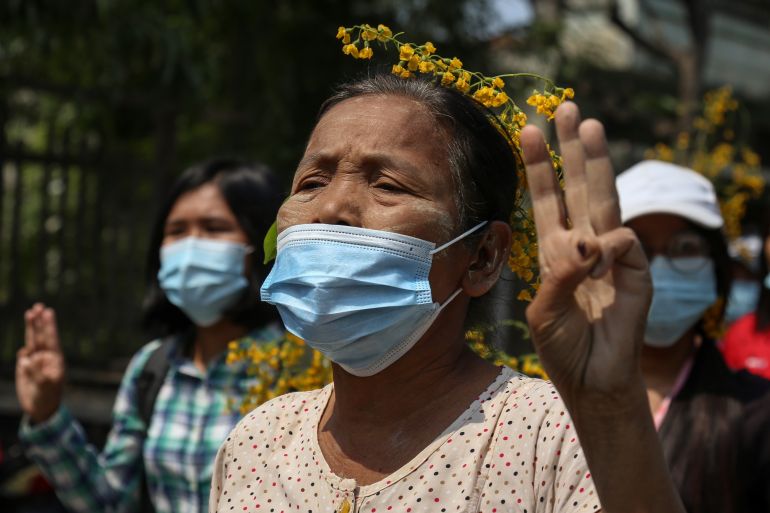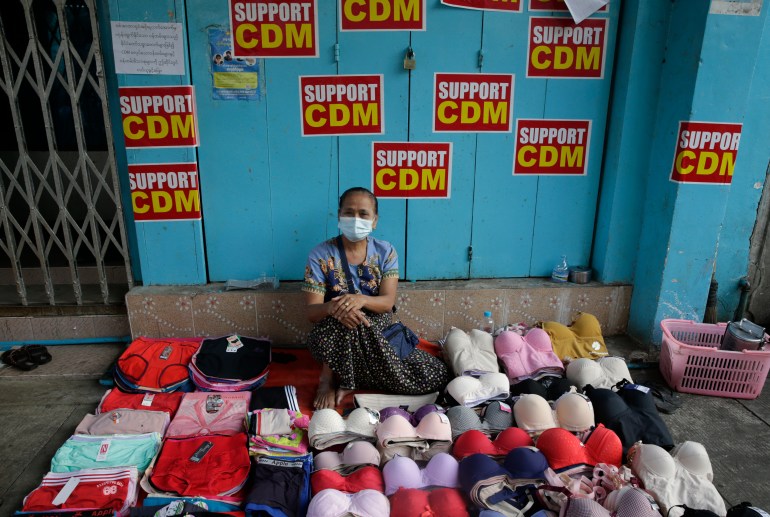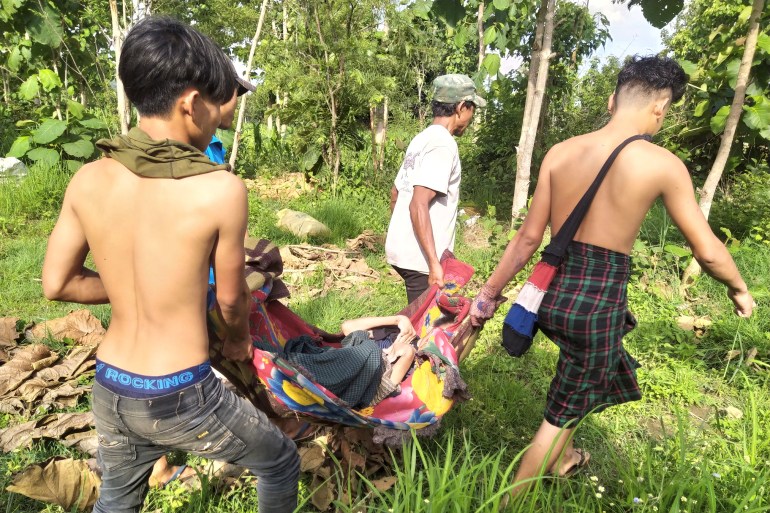Military attacks endanger people with limited mobility in Myanmar
Over 60s and those with disabilities face greater risks as military crackdown on anti-coup movement continues.

Over the past nine months, Daw Mu Ree has hidden in the forest outside her village to avoid military attacks in Myanmar’s northwestern Sagaing region more times than she can count.
At 83, she is unable to walk fast or far, so her son and daughter carry her.
Keep reading
list of 4 itemsUS declares Myanmar army committed genocide against Rohingya
UN accuses Myanmar army of war crimes, torture, killings
Myanmar defectors describe military culture of abuse, fear
“I told them to leave me behind…but they won’t leave me,” she said. “Whenever we flee, they carry me on their backs and run.”
In the forest, Daw Mu Ree and her children usually sleep under a sheet of tarpaulin or between large rocks, relocating when they hear soldiers nearby. She spends these nights hungry, fending off mosquitoes and sandflies, and tormented with worry about her health and safety.
“I wish I would die,” she told Al Jazeera. “[Soldiers] block all the food and medicine and we are mostly fleeing and hiding in the dense forest. It is very difficult for an old woman like me.”
Research has found that people over the age of 60 and those with disabilities are particularly at risk during humanitarian crises. Their family and community support structures may be affected, and they may face limited access to health care facilities, nutritious food or humanitarian assistance. Those with limited mobility are also at risk of being left behind or separated from family when they are forced to flee by fighting.
Al Jazeera spoke to two displaced people and one civil society worker in areas of Myanmar affected by armed conflict in the wake of the February 2021 military coup. They described a range of ways that the crisis imperils older people, who currently make up about 9 percent of Myanmar’s population, and people with disabilities.
For security reasons, pseudonyms have been used for Daw Mu Ree and the other residents.

While millions of people across Myanmar peacefully demonstrated in the weeks following the coup, the military’s use of killings, arrests, and torture to suppress resistance to its rule has pushed many civilians to take up arms. Pro-democracy armed groups, many of which call themselves People’s Defence Forces (PDFs), have rapidly gathered momentum since May, while fighting between the military and several existing ethnic armed groups has also reignited.
The deepening conflict has forced more than 500,000 people from their homes, with a further 48,000 fleeing to neighbouring countries, according to United Nations estimates.
The UN’s annual Humanitarian Response Plan released in January identifies 14.4 million people in Myanmar in need of humanitarian assistance in 2022 – compared with 1 million people identified at the beginning of 2021. At least 1.9 million of those identified have disabilities and 1.2 million are over the age of 60.
Last October, the nonprofit HelpAge International published an assessment on the needs of older people and people with disabilities in Myanmar since the coup. It found that needs had increased with respect to food, health, income, livelihood and security, while many of those surveyed were “extremely worried” about military attacks.
“They fear that when their villages are raided, they will be forgotten in the chaos, and left behind to face whatever terror is coming,” Michiel de Groot, the organisation’s resource development manager, told Al Jazeera.
Paying with their lives
The inability to flee has at times cost older people in Myanmar their lives, media reports from the past year suggest.
At least six older people burned to death in their homes after they stayed or were left behind when others fled and soldiers set fire to their villages – in Magway region’s Pauk township last June, Sagaing region’s Yinmarbin township this February, and Taze township, also in Sagaing, on March 12. Two older people were also found dead in February following military raids and air attacks on their village in Sagaing region’s Ye-U township.
Those who seek shelter in camps or religious buildings are also not safe, as the military has targeted these sites as well. On March 8, the military shelled a monastery in Sagaing region’s Yinmarbin township where people unable to run far had been staying. The artillery fire killed five older people and injured five more. A mother and her two children were also killed in the shelling.
An 89-year-old woman is the latest victim of junta’s ongoing campaign to uproot Chin communities from their homes. The elderly woman died in a small village in Mizoram State where she arrived only 3 weeks ago after making a 200-mile journey from her village in Matupi Township. pic.twitter.com/RksCxnXEau
— ChinHumanRightsOrg (@ChinHumanRights) February 9, 2022
Al Jazeera was unable to independently verify the details of the incidents.
Traumatic experiences and limited access to health care can also pose life-threatening risks for older people in conflict-affected areas. The Chin Human Rights Organization reported in February that dozens of older people had died of treatable illnesses while fleeing military attacks in Myanmar’s northwest, and that others died because they were unable to get medical treatment or proper food after fleeing across the border into India’s Mizoram State.
Daw Mu Ree is from Mingin township, where hundreds of homes have been razed following military raids and several villagers have gone missing or been found dead in recent months. The attacks mark part of a broader pattern across Sagaing region, which has seen intense fighting between the military and civilian resistance groups since May. At least 136,000 people have been displaced, while the military has carried out air attacks across more than half of the region’s 37 townships, according to the UN.
Fear of military raids is the culmination of mounting troubles Daw Mu Ree has faced since the coup. Not only has her household income from rice paddy farming been affected, but she no longer receives the 30,000 kyats a month ($22.60 as of Jan 2021) in social pensions she used to receive from the civilian government that was overthrown by the military.
Meanwhile, the military has blocked supply routes and confiscated and destroyed relief items in areas of armed resistance across the country, and many conflict-affected areas are facing shortages of essential goods and rising prices, according to media reports.
Daw Mu Ree told Al Jazeera that she used to take medicine and drink nutritional supplements daily, but can no longer find a way to buy them. Although she tried ordering them from nearby towns, the items never reached her.
“Since the military coup, we cannot eat what we want or go where we like. We are constantly running. My children are trying their best to take care of me, but we have to flee often,” she said. “As an older person, I cannot do anything to change the situation. I cannot even take care of myself. I am so frustrated.”
Using drone imagery published by Chindwin Chit Thu, Myanmar Witness has been able to map approximately 185 structures in Bin, Mingin (Sagaing) that were burnt on Wednesday night.#WhatsHappeningInMyanmar #MWInvestigates https://t.co/fXq5Rarb01 pic.twitter.com/ZaDB3yyUf3
— Myanmar Witness (@MyanmarWitness) February 5, 2022
‘No such thing as safety’
In Kayah and neighbouring southern Shan State in Myanmar’s southeast, more than 150,000 people have been displaced since fighting exploded in May.
Naw Katherine, a civil society worker, described three cases in which older people died as a result of the crisis.
In Kayah State’s Demoso township, one older man hanged himself in a displacement camp and one older woman died of unknown causes while fleeing a military bombing on her village.
Naw Katherine said her organisation was unable to take the woman to hospital because its patients were being evacuated for their safety. “She just passed away while travelling to the displacement camp,” said Naw Katherine. She also said that in Loikaw township, one older man died after being left behind to guard a convent school during military attacks. Al Jazeera was unable to independently verify these incidents.
Naw Katherine says that limited resources in the face of enormous humanitarian needs have left her organisation, which works with all vulnerable populations, unable to provide adequate specialised support for older people and people with disabilities, but that they have tried to help those with limited mobility to flee military attacks by arranging vehicles or carrying them on foot.
“It is very difficult – for example, when going from place to place or needing to flee urgently, they need someone to take care of them or guide them,” she said. “When I see their eyes, I can see that they feel small and burdensome.”
She adds that many older people have decided to stay behind when others have fled. “Some older people told me they couldn’t run and they didn’t want to run. They wanted to remain in their houses despite the life-threatening situation.”

Fighting has also displaced thousands in Myanmar’s northernmost Kachin State, where the coup has inflamed hostilities between the military and the Kachin Independence Army (KIA), an ethnic armed group, and where PDF groups have at times joined together with the KIA in combat.
When clashes reached the state’s far northern Puta-O township in February and the military began dropping bombs from fighter planes, Brang Jet told his family to leave the village without him. The 50-year-old farmer and father of three lost his leg in a motorbike accident last June, and relies on crutches to walk.
“It is more difficult for me because I cannot run like others,” he said. “Everyone fled together, but I was left behind and slowly tried to catch up.”
Accompanied by one villager, Brang Jet eventually reunited with his family in the forest, where they built shelters out of tarpaulin and bamboo along with others from their village.
Having fled in haste, they could not even bring blankets.
With limited humanitarian support and meagre supplies of food, many older people have been falling sick.
“It has been a long time since we have been able to access some food items like garlic, onions, oil and spices,” Brang Jet said. “We eat vegetables with salt. We are not even sure how long our rice can last.”
The villagers have also been unable to remain in one place for long because of the ongoing fighting.
“We are fleeing here and there again and again,” he said. “It is very difficult. There is no such thing as safety.”
This article was supported by a grant from ARTICLE 19 under Voices for Inclusion, a project funded by the Netherlands Ministry of Foreign Affairs.